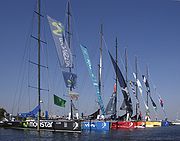
Volvo Open 70
Encyclopedia


Volvo Ocean Race
The Volvo Ocean Race is a yacht race around the world, held every three years. It is named after its current owner, Volvo...
. It was first used in the 2005-2006 race (replacing the Volvo Ocean 60
Volvo Ocean 60
The Whitbread 60 or Volvo Ocean 60 was the forerunner to the current class of racing designed for the Volvo Ocean Race, the Volvo Open 70....
yachts which were first used in 1993) and use a Canting keel
Canting keel
A canting keel is a form of sailing ballast, suspended from a rigid canting strut beneath the boat, which can be swung to windward of a boat under sail, in order to counteract the heeling force of the sail...
which is capable of canting transversely up to an angle of 40 degrees.
According to the VO70 rule, the yachts can be made from glass fibres
Fiberglass
Glass fiber is a material consisting of numerous extremely fine fibers of glass.Glassmakers throughout history have experimented with glass fibers, but mass manufacture of glass fiber was only made possible with the invention of finer machine tooling...
, aramid fibres
Aramid
Aramid fibers are a class of heat-resistant and strong synthetic fibers. They are used in aerospace and military applications, for ballistic rated body armor fabric and ballistic composites, in bicycle tires, and as an asbestos substitute. The name is a portmanteau of "aromatic polyamide"...
, or carbon fibres
Carbon fiber
Carbon fiber, alternatively graphite fiber, carbon graphite or CF, is a material consisting of fibers about 5–10 μm in diameter and composed mostly of carbon atoms. The carbon atoms are bonded together in crystals that are more or less aligned parallel to the long axis of the fiber...
(which were not allowed for the VO60’s).
Version 2 of the VO70 rule which “has been further developed to apply the lessons learned on the last event and ensure the continuing evolution of this outstanding class” was released in September 2006.
A revised VO70 rule, version 3, has been released in 2011.
Measurements
| Attribute | Metric | Imperial |
|---|---|---|
| Length Overall | 21.5 m | 70.5 ft |
| Beam Beam (nautical) The beam of a ship is its width at the widest point. Generally speaking, the wider the beam of a ship , the more initial stability it has, at expense of reserve stability in the event of a capsize, where more energy is required to right the vessel from its inverted position... |
5.7 m | 18.7 ft |
| Draft Draft (hull) The draft of a ship's hull is the vertical distance between the waterline and the bottom of the hull , with the thickness of the hull included; in the case of not being included the draft outline would be obtained... |
4.5 m | 14.8 ft |
| Mast Mast (sailing) The mast of a sailing vessel is a tall, vertical, or near vertical, spar, or arrangement of spars, which supports the sails. Large ships have several masts, with the size and configuration depending on the style of ship... |
31.5 m | 103.3 ft |
| Displacement Displacement (ship) A ship's displacement is its weight at any given time, generally expressed in metric tons or long tons. The term is often used to mean the ship's weight when it is loaded to its maximum capacity. A number of synonymous terms exist for this maximum weight, such as loaded displacement, full load... |
14,000 kg | 30,870 lb |
| Depth (canting keel) | 4.5 m | 14.8 ft |
| Ballast Sailing ballast Ballast is used in sailboats to provide moment to resist the lateral forces on the sail. Insufficiently ballasted boats will tend to tip, or heel, excessively in high winds. Too much heel may result in the boat capsizing. If a sailing vessel should need to voyage without cargo then ballast of... |
7,400 kg | 16,320 lb |
| Mainsail Mainsail A mainsail is a sail located behind the main mast of a sailing vessel.On a square rigged vessel, it is the lowest and largest sail on the main mast.... |
175 m² | 1,883 sq' |
| Storm Jib | 35 m² | 376 sq' |
| Jib Jib A jib is a triangular staysail set ahead of the foremast of a sailing vessel. Its tack is fixed to the bowsprit, to the bow, or to the deck between the bowsprit and the foremost mast... |
94 m² | 1,011 sq' |
| Spinnaker Spinnaker A spinnaker is a special type of sail that is designed specifically for sailing off the wind from a reaching course to a downwind, i.e. with the wind 90°–180° off the bow. The spinnaker fills with wind and balloons out in front of the boat when it is deployed, called flying. It is constructed of... (Masthead) |
500 m² | 5,381 sq' |
| Spinnaker Spinnaker A spinnaker is a special type of sail that is designed specifically for sailing off the wind from a reaching course to a downwind, i.e. with the wind 90°–180° off the bow. The spinnaker fills with wind and balloons out in front of the boat when it is deployed, called flying. It is constructed of... (Fractional Rig) |
350 m² | 3,767 sq' |
| Storm Trysail | 41 m² | 441 sq' |
Current Record
Since the launch of the class it has proven itself to be the fastest monohull sailboat class ever built. Today all major monohull records are established by VO70's. For example:In October 2008 the yacht Ericsson 4 officially travelled 596.6 nautical miles in 24 hours, establishing a 24 hour monohull record.
Skipper Torben Grael and his crew made the record on the first leg of the 2008-2009 Volvo Ocean Race. They sailed Ericsson 4 hard as a strong cold front hit the fleet, bringing winds approaching 40 knots, and propelling the yacht at an average speed of 24.8 knots.
In 2010 the VO70 Delta Lloyd (former ABN AMRO 1) established a new english channel record with skipper Bouwe Bekking. In 2010 the VO70 groupama 70 (former Ericsson 4) broke the record for the round Britain and Ireland Race.. In July 2011 the VO70 Puma Mar Mostro won the TR 2011 on handicap, finishing second only to Rambler 100. At the Fastnet 2011 the three first monohulls were all VO70's and they all broke the existing monohull record. The record now stands at 1d 18hrs and 39 min.

